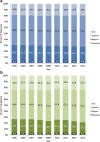Breast Density Notification Legislation and Breast Cancer Stage at Diagnosis: Early Evidence from the SEER Registry
- PMID: 27844260
- PMCID: PMC5442000
- DOI: 10.1007/s11606-016-3904-y
Breast Density Notification Legislation and Breast Cancer Stage at Diagnosis: Early Evidence from the SEER Registry
Abstract
Background: Twenty-eight states have passed breast density notification laws, which require physicians to inform women of a finding of dense breasts on mammography.
Objective: To evaluate changes in breast cancer stage at diagnosis after enactment of breast density notification legislation.
Design: Using a difference-in-differences analysis, we examined changes in stage at diagnosis among women with breast cancer in Connecticut, the first state to enact legislation, compared to changes among women in control states. We used data from the Surveillance, Epidemiology, and End Results Program (SEER) registry, 2005-2013.
Participants: Women ages 40-74 with breast cancer.
Intervention: Breast density notification legislation, enacted in Connecticut in October of 2009.
Main measure: Breast cancer stage at diagnosis.
Key results: Our study included 466,930 women, 25,592 of whom lived in Connecticut. Legislation was associated with a 1.38-percentage-point (95 % CI 0.12 to 2.63) increase in the proportion of women in Connecticut versus control states who had localized invasive cancer at the time of diagnosis, and a 1.12-percentage-point (95 % CI -2.21 to -0.08) decline in the proportion of women with ductal carcinoma in situ at diagnosis. Breast density notification legislation was not associated with a change in the proportion of women in Connecticut versus control states with regional-stage (-0.09 percentage points, 95 % CI -1.01 to 1.02) or metastatic disease (-0.24, 95 % CI -0.75 to 0.28). County-level analyses and analyses limited to women younger than 50 found no statistically significant associations.
Limitations: Single intervention state, limited follow-up, potential confounding from unobserved trends.
Conclusions: Breast density notification legislation in Connecticut was associated with a small increase in the proportion of women diagnosed with localized invasive breast cancer in individual-level but not county-level analyses. Whether this finding reflects potentially beneficial early detection or potentially harmful overdiagnosis is not known. Legislation was not associated with changes in regional or metastatic disease.
Keywords: breast cancer; cancer screening; health policy.
Conflict of interest statement
Conflict of Interest
The authors declare that they do not have a conflict of interest.
Disclaimer
This work does not necessarily represent the views of the Department of Veterans Affairs, and the authors are solely responsible for its content.
Figures


Comment in
-
Supplemental Breast Cancer Screening: A Density Conundrum.J Gen Intern Med. 2017 Jun;32(6):593-594. doi: 10.1007/s11606-017-3989-y. J Gen Intern Med. 2017. PMID: 28243876 Free PMC article. No abstract available.
Similar articles
-
The impact of legislation mandating breast density notification - Review of the evidence.Breast. 2018 Dec;42:102-112. doi: 10.1016/j.breast.2018.09.001. Epub 2018 Sep 11. Breast. 2018. PMID: 30236594 Free PMC article. Review.
-
Dense breast legislation in the United States: state of the states.J Am Coll Radiol. 2013 Dec;10(12):899-902. doi: 10.1016/j.jacr.2013.09.007. J Am Coll Radiol. 2013. PMID: 24295937
-
The Effect of California's Breast Density Notification Legislation on Breast Cancer Screening.J Prim Care Community Health. 2017 Apr;8(2):55-62. doi: 10.1177/2150131916674889. Epub 2016 Oct 31. J Prim Care Community Health. 2017. PMID: 27799412 Free PMC article.
-
The Impact of Breast Density Notification Laws on Supplemental Breast Imaging and Breast Biopsy.J Gen Intern Med. 2019 Aug;34(8):1441-1451. doi: 10.1007/s11606-019-05026-2. Epub 2019 May 29. J Gen Intern Med. 2019. PMID: 31144277 Free PMC article.
-
Dense Breast Legislation in the United States: State of the States.J Am Coll Radiol. 2016 Nov;13(11S):R53-R57. doi: 10.1016/j.jacr.2016.09.027. J Am Coll Radiol. 2016. PMID: 27814815 Review.
Cited by
-
Supplemental Breast Cancer Screening: A Density Conundrum.J Gen Intern Med. 2017 Jun;32(6):593-594. doi: 10.1007/s11606-017-3989-y. J Gen Intern Med. 2017. PMID: 28243876 Free PMC article. No abstract available.
-
The impact of legislation mandating breast density notification - Review of the evidence.Breast. 2018 Dec;42:102-112. doi: 10.1016/j.breast.2018.09.001. Epub 2018 Sep 11. Breast. 2018. PMID: 30236594 Free PMC article. Review.
-
Combined diagnosis of breast cancer in the early stage by MRI and detection of gene expression.Exp Ther Med. 2018 Aug;16(2):467-472. doi: 10.3892/etm.2018.6242. Epub 2018 May 31. Exp Ther Med. 2018. PMID: 30112019 Free PMC article.
-
The impact of mandatory mammographic breast density notification on supplemental screening practice in the United States: a systematic review.Breast Cancer Res Treat. 2021 May;187(1):11-30. doi: 10.1007/s10549-021-06203-w. Epub 2021 Mar 28. Breast Cancer Res Treat. 2021. PMID: 33774734
-
Breast Density Legislation and the Promise Not Attained.J Gen Intern Med. 2019 Feb;34(2):167-168. doi: 10.1007/s11606-018-4754-6. J Gen Intern Med. 2019. PMID: 30478631 Free PMC article. No abstract available.
References
MeSH terms
Grants and funding
LinkOut - more resources
Full Text Sources
Other Literature Sources
Medical

